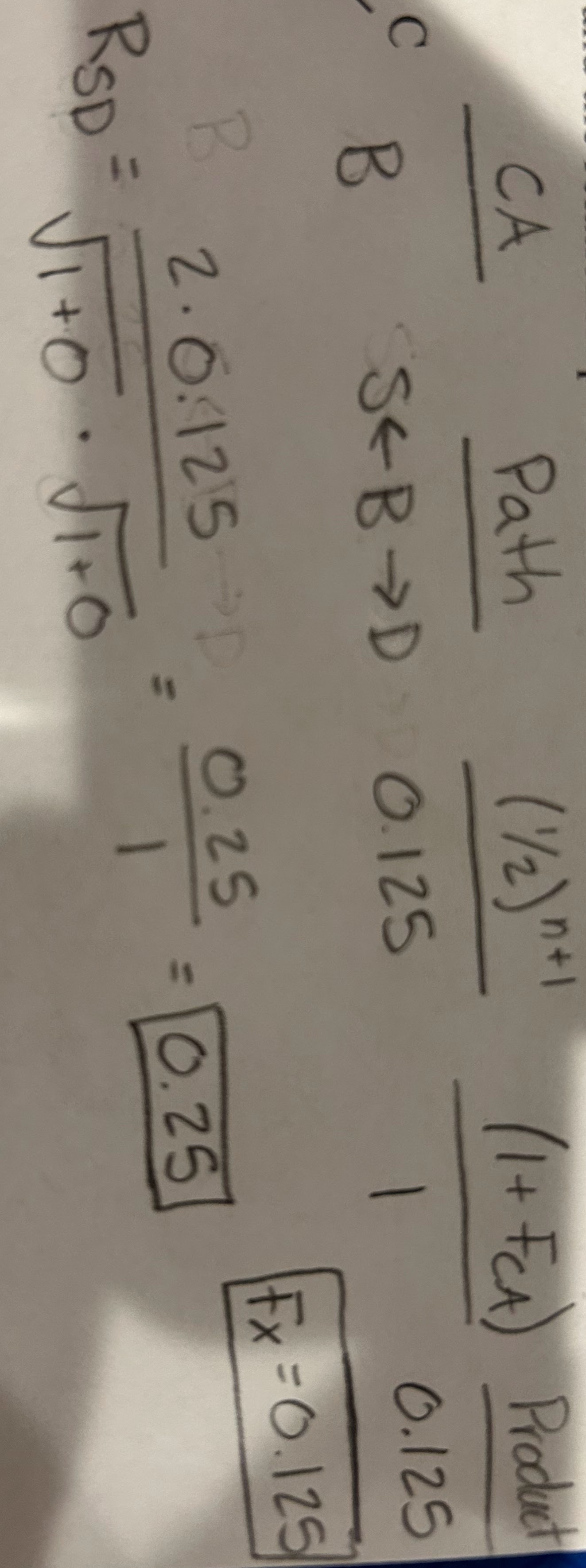AS 332 Exam 5
1/44
There's no tags or description
Looks like no tags are added yet.
Name | Mastery | Learn | Test | Matching | Spaced |
|---|
No study sessions yet.
45 Terms
Define, phenotypic correlation, genetic correlation, and environmental correlation
Phenotypic correlation - strength and direction of the relationship between two phenotypes
Genetic correlation - strength and direction of the relationship between two breeding values
Environmental correlation - strength and direction of the relationship between environment effects for two traits
what is meant by “correlation response to selection”
selection for one trait also changes a genetically correlated trait
Define pleiotropy
when the same allele affects more than one trait
define economically relevant trait
a trait that directly affects profit
define indicator trait and provide an example of an indicator trait in the livestock industry
a trait that by itself is unimportant but is genetically correlated with an economically relevant trait - birth weight, scrotal circumference
What causes genetic correlations? (Two answers needed for full credit)
pleiotropy, linkage
what are three reasons why indirect selection on an indicator trait is preferable to direct selection on an economically relevant trait? Answer in general terms rather than for specific traits
Indicator traits are sometimes easier to measure
You can achieve higher selection accuracy using an indicator trait
You can achieve higher selection intensity using an indicator trait
Indicator traits are sometimes cheaper to measure
what is the difference between a negative genetic correlation and an unfavorable genetic correlation
Negative - BVs for 2 traits expected to move in opposite directions
Unfavorable - correlation you don’t want
A herdsman (or woman) is selecting only for heavier weaning weights. (S)he is improving weaning weights by 4 lbs.per year. The genetic correlation between weaning and birth weight is +0.55. The standard deviations of breeding values for weaning and birth weights in this herd are 30 lbs. and 6 lbs., respectively.
A. How much is this herdsman (or woman) increasing birth weight per year?
B. Is the above genetic correlation positive or negative? Is the above genetic correlation favorable or unfavorable?
A. b = +0.55 (6/30) = 0.11 BV/T(BW) = 0.11 4 = 0.44 lbs/year
B. Positive and unfavorable
Correlation coefficients measure the direction and degree of association between 2 variables and are used in a variety of ways in quantitative animal breeding. What are the 2 variables involved in each of the correlations below?
A. Genetic correlation
B. Accuracy of EBV
C. Heritability
A. BV for trait 1, BV for trait 2
B. EBV, true BV
C. BV, Phenotype
List the three methods of multiple trait selection and indicate which method produces the slowest rate of genetic change in traits included in your breeding objective and which method produces the fastest rate of genetic change in traits included in your breeding objective. Assume each method of multiple trait selection is applied correctly
Tandem selection (Slowest)
Independent culling levels
Economic selection index (Fastest)
Selection intensity for any single trait [increases, decreases, does not change] as number of traits selected for increases
Decreases
What is the main factor that determines whether a trait should be included in a breeding objective
profit
When practicing multiple trait selection, the loss of selection intensity is greater when the traits are [favorably, unfavorably, not] genetically correlated
unfavorably
what is one of the main consequences of multiple trait selection in comparison to single trait selection
loss of selection intensity
The progress from selection for two traits simultaneously depends on whether the genetic correlation between the traits in favorable or unvavorable. Compare the success of selection when the correlation is favorable or unfavorable
Faster genetic progress for two traits when favorable genetically correlated. Slower genetic progress when unfavorably genetic correlated
List one advantage and one disadvantage of each of the three methods of multiple trait selection
Tandem Selection - Very easy to do - Slowest rate of genetic change
Independent culling levels - Allows breeders to set their own empasise for traits in thier breeding objective - Traits are not weighed by economic value
Economic selection index - Fastest rate of genetic change overall - Hard to develop on your own
What are the similarities and differences between truncation selection and selection by independent culling levels
Both - both approaches set thresholds for traits
Truncation - 1 trait
ICL - multiple traits
The term ‘selection index’ has been used for calculation of estimated breeding values and for multiple trait selection. What is one essential difference between these 2 applications of the selection index technique? You could answer in terms of either the data used in the calculation (x’s) or the kind of information that results from the calculation (y’s)
Selection index =
y = 1. EBV 2. ESI
x = 1. Phenotype (From different related animals for same trait) 2. EPDs (From same animal, different traits)
Following are fleece weights and lamb weaning weights for 3 ewes, adjusted for age of the ewe. Using appropriate heritabilities, standard deviations, and genetic and phenotypic correlations to calculate a selection index, the seleciton index that predicts the breeding objective is the following: Y = (2.9 * Fleece Weight) + (1 * Lamb Weight)
Calculate the selection index (Y) for each ewe
EWE FLEECE WEIGHT LAMB WEIGHT SELECTION INDEX VALUE ($)
2941 5.8 lbs. 124 lbs.
2929 9.0 lbs. 102 lbs.
2963 8.5 lbs. 100 lbs.
2941 = $140.82
2929 = $128.10
2963 = $124.65
You want to save lambs from 3 ewes to raise as replacements for the ewe flock. You can select from the lambs below
EWE FLEECE WEIGHT LAMB WEIGHT SELECTION INDEX VALUE ($)
2941 5.8 lbs. 124 lbs. $140.82
2929 9.0 lbs. 102 lbs. $128.10
2963 8.5 lbs. 100 lbs. $124.65
2991 7.0 lbs. 101 lbs. $121.30
2952 8.5 lbs. 93 lbs. $117.70
3050 7.0 lbs. 82 lbs. $102.30
3067 9.1 lbs. 68 lbs. $94.40
3100 7.5 lbs. 63 lbs. $84.80
3028 8.6 lbs. 55 lbs. $79.90
3169 4.5 lbs. 50 lbs. $63.10
A. If you were to use tandem selection, beginning with fleece weight, from which 3 ewes would you save lambs
B. If you were to use tandem selection, beginning with lamb weight, from which 3 ewes would you save lambs?
C. If you were to use independent culling levels, saving lambs only from ewes with = or > 8 lb. fleece weight and = or > 80 lbs. lamb weight, which ewes would you select?
D. If you were to use the selection index, from which 3 ewes would you save lambs?
A. 3067, 2929, 3028
B. 2941, 2929, 2991
C. 2952, 2963, 2929
D. 2941, 2929, 2963
$Weaned Calf, $Cow Energy, TPI, $Net Merit, the Maternal-line Index, Terminal Sire Index, and Maternal Wool Index are all examples of what method of multiple trait selection?
Economic selection index
What is the difference between a breeding value and a selection index
EBV - estimating genetic merit for 1 trait
ESI - multiple trait selection tool
For a selection index calculated by a breed association of your choice:
A. What traits are factored into the index?
B. Why would a breeder or producer use the index you have chosen?
$Feedlot
A. CW, DMI, Pg (Post-weaning Gain = YW - WW)
B. fAllows owners to make selection decisions by predicting the profitability of a bull’s progeny in a feedlot and allow better $ obtained when sold on a carcass basis
Define random mating, positive assortative mating, and negative assortative mating
Random mating - randomly pairing sires with dams
Positive assortative mating - mating selected animals with similar phenotypes
Negative assortative mating - mating selected animals with opposite phenotypes
Which type of mating strategy will result in greater genetic variation? Less genetic variation?
Increase - positive assortative mating
Decrease - negative assortative mating
differentiate between random mating and random selection
Mating - randomly pairing selected sires and dams
Selection - ignoring a trait when making selection decisions
For each of the following scenarios, indicate whether random, positive assortative, or negative assortative mating is the most appropriate mating system to use in the herd or flock. Give 1 answer for each scenario
A) A commercial swine producer breeds Hampshire boars to Yorkshire x Landrace crossbred sows in a terminal crossbreeding system and keeps no pedigree records on the progeny.
B) A commercial dairy producer has too much variability in his or her cows in body size. In a stanchion barn, the large cows have their rear quarters in the gutter and get dirty and the small cows can’t reach the gutter and soil the bedding when they urinate and defecate and also get dirty.
C) A breeder of rodeo bulls wants to breed a future All-American rodeo bull.
D) A breeder of Hereford beef cattle wants to produce a high EPD bull for yearling weight that will be purchased by an international A.I. organization
A. Random
B. Negative
C. Positive
D. Positive
For each of the following scenarios, indicate if random mating, positive assortative mating, or negative assortative mating is used
A) Ten bulls with high EPDs for weaning weight are turned into a lot with 200 cows.
B) A breeder of Quarter Horses has a stable of mares with too much set (curvature) to their rear legs. The breeder selects a stallion with extremely straight rear legs to mate to these mares.
C) A dairy producer is using 3 A.I. bulls selected for high PTA (EPD) milk. The bulls are used in rotation as the cows come into heat.
D) Selected roosters and hens are ranked from highest to lowest for 6 week body weight. The first rooster is mated to the first group of hens, the second rooster is mated to the second group of hens, the last rooster is mated to the last group of hens.
E) Three beef bulls are used. The bull with the highest yearling height EPD is mated to the cows with the lowest yearling height EPDs, the bull with the intermediate yearling height EPD is mated to the cows with the intermediate yearling height EPDs, and the bull with the lowest yearling height EPD is mated to the cows with the highest yearling height EPDs
A. Random
B. Negative
C. Random
D. Positive
E. Negative
In a flock of sheep, 5 rams are each mated to 20 ewes. The ram with the highest EPD for fleece weight is mated to the 20 ewes with highest EPDs for fleece weight, the ram with the second highest EPd is mated to the 20 ewes with the next highest EPDs, and so forth until the ram with the lowest EPD for fleece weight is mated to the 20 ewes with the lowest EPDs for fleece weight. what type of mating system is being applied
Positive
In a dairy herd, cows with the poorest udder conformation are mated to the bull with the highest PTA (EPD) for udder conformation. this is corrective mating. what is another term for corrective mating
Negative assortative mating (structural traits)
Inbreeding results in an increase in the proportion of [homozygous, heterozygous] loci
homozygous
define inbreeding depression
decreased performance resulting from increased inbreeding levels
fertility and survivability traits are affected the [most, least] by inbreeding depression while carcass traits are affected the [most, least] by inbreeding depression.
carcass, skeletal structure = high heritability, low inbreeding depression
weight, yield = moderate heritability, moderate inbreeding depression
fertility, survivability = low heritability, high inbreeding depression
if two alleles at a locus are identical by descent, what does this mean
both alleles come from same common ancestor
what are two strategies that can be used to reduce the effects of inbreeding depression in a herd, assuming inbreeding is a problem
Bring in unrelated genetics (outbreeding)
Crossbreed
Pair sires and dams that are least related
Compare and contrast inbreeding coefficient with relationship coefficient
Both calculate probability of identity by descent alleles
Inbreeding - probability that 2 alleles at a locus in an animal are indentity by descent
Relationship - probability that 2 alleles at a locus between 2 animals are identity by descent
Two sows in the sam eherd have different inbreeding coefficients. Belle’s inbreeding coefficient is 0.30 and Grace’s inbreeding coefficient is zero
A. what do the inbreeding coefficients tell us about the genotypes of the two sows
B. the two sows have the same breeding value for litter size. Are the two sows expected to give birth to a different number of piglets? Explain
C. Which sow is expected to produce female offspring that have the largest litter sizes? Why?
A. 30% more homozygousity in Belle than Grace
B. Yes - Belle is affected more by inbreeding depression
C. Neither - Both sows have same litter size BV and inbreeding cannot be passed from parent to offspring
Compare and contrast indentity by descent with identity by state
Same - All identity by descent alleles also need to be indentity by state
Only identity by descent allels are derived from a common ancestor
In the basic genetic model, genotypic value is composed of two components. Which component is changed due to inbreeding? why?
GCV - increase in homozygousity reduces GCV
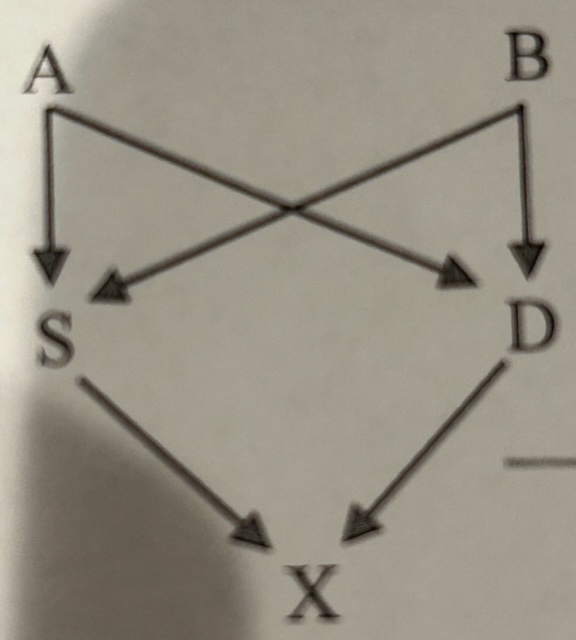
Calculate the inbreeding coefficient for X and the relationship coefficient between S and D

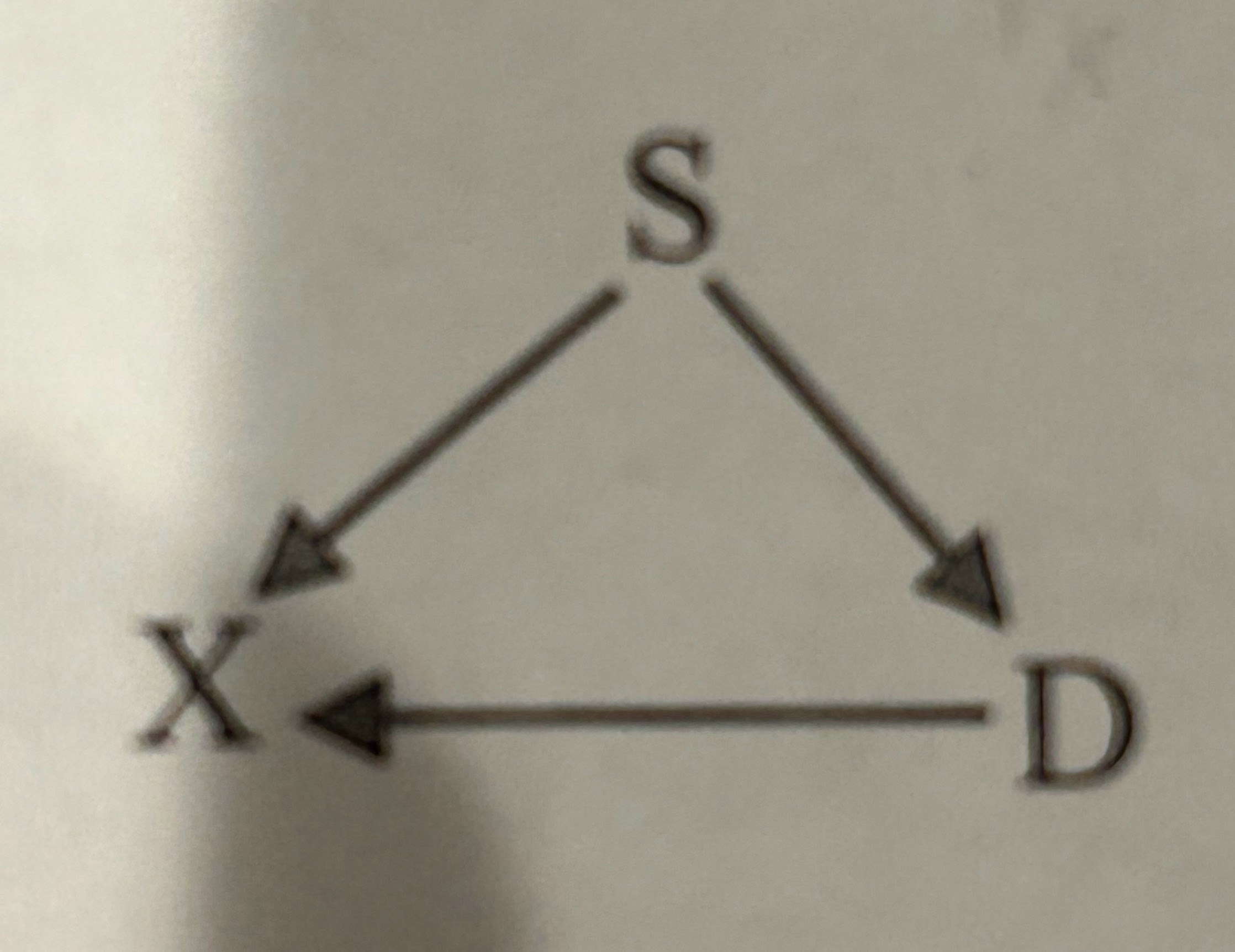
Calculate the inbreeding coefficient for X and the relationship coefficient between S and D

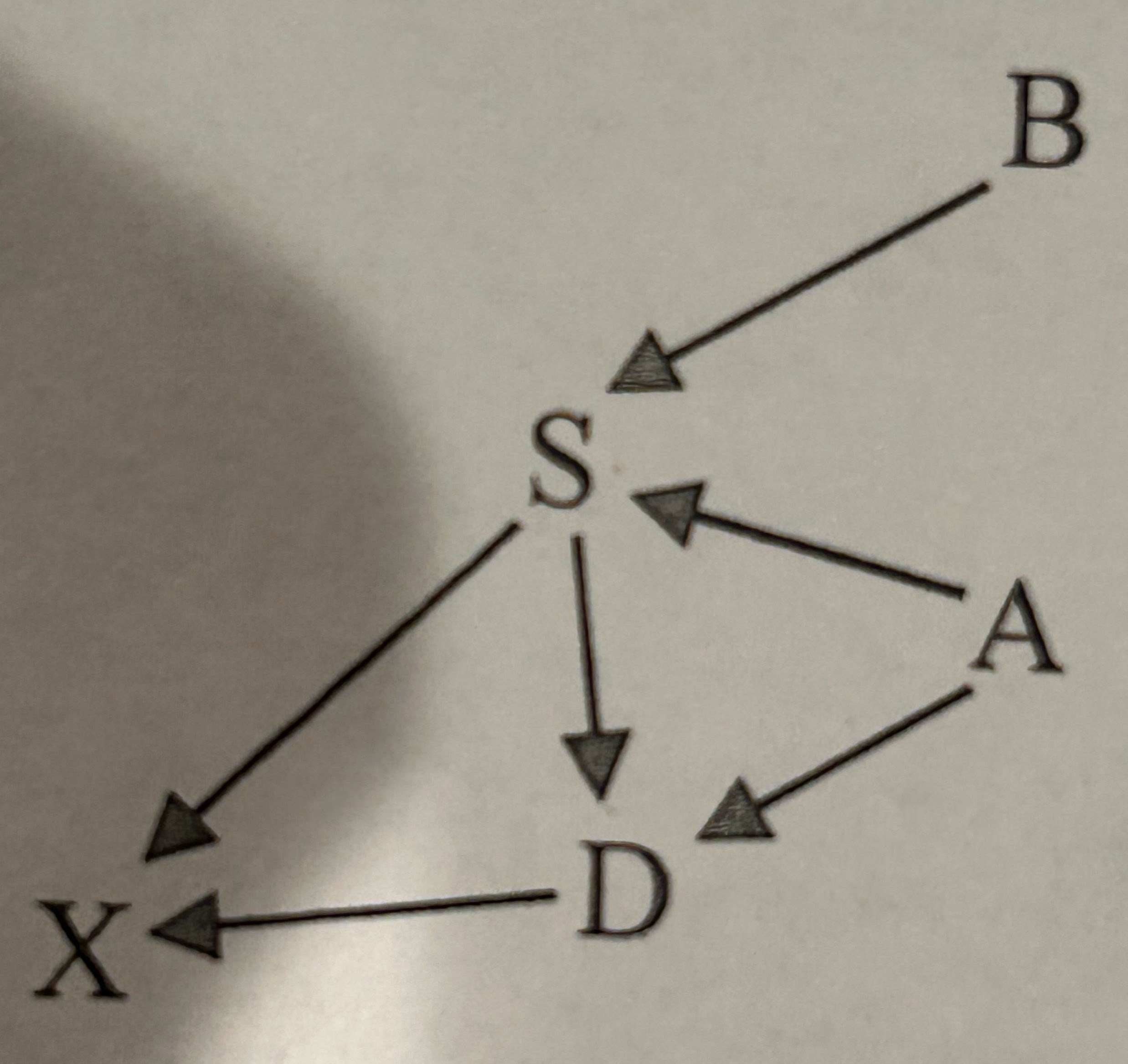
Calculate the inbreeding coefficient for X and the relationship coefficient between S and D
CA Path (1/2)n+1 (1+FCA) Product
A →S 0.25 1 0.25
FD = 0.25

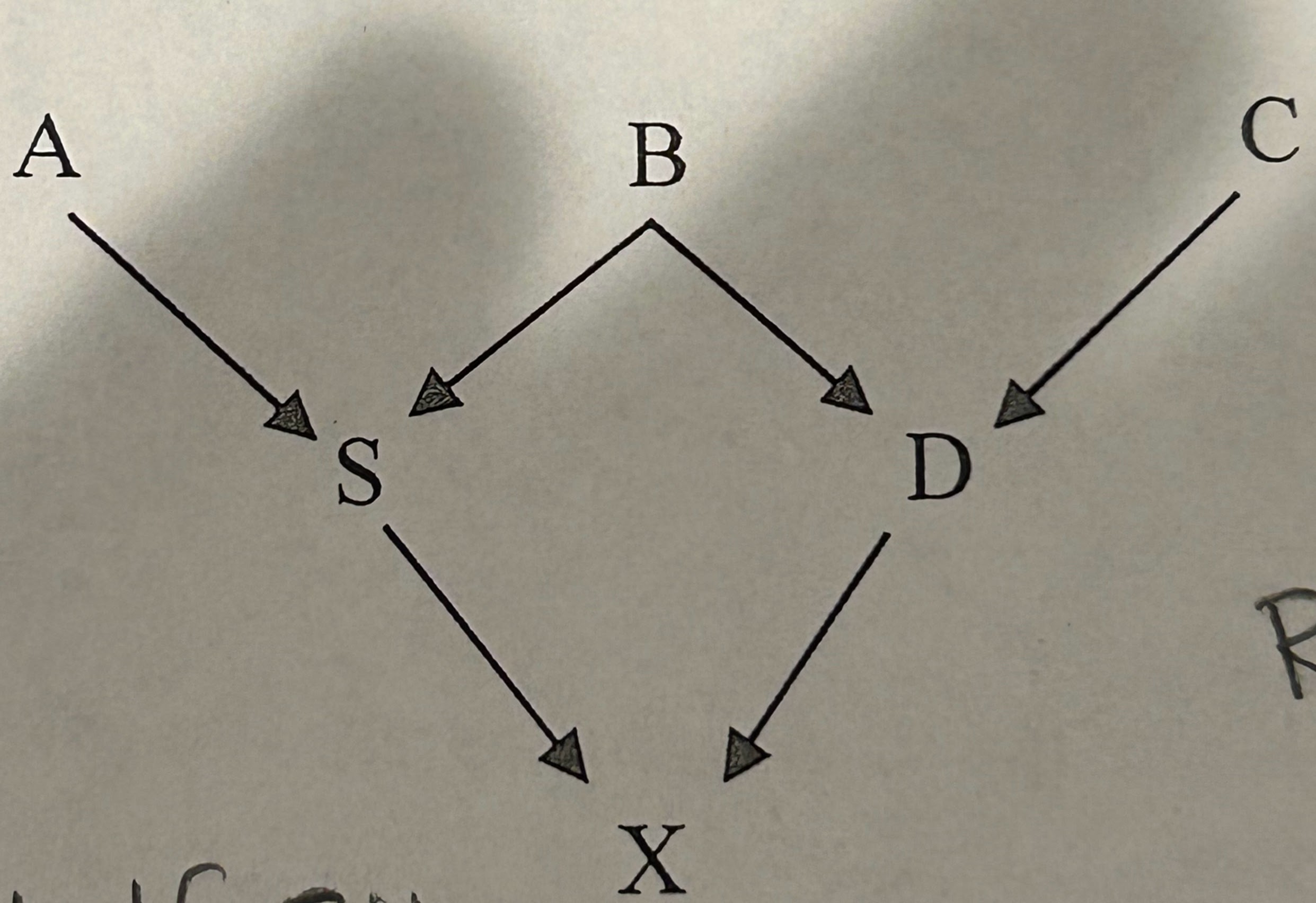
Calculate the inbreeding coefficient for X and the relationship coefficient between S and D
